2023 TOYOTA C-HR first
[x] Cancel search: firstPage 40 of 814
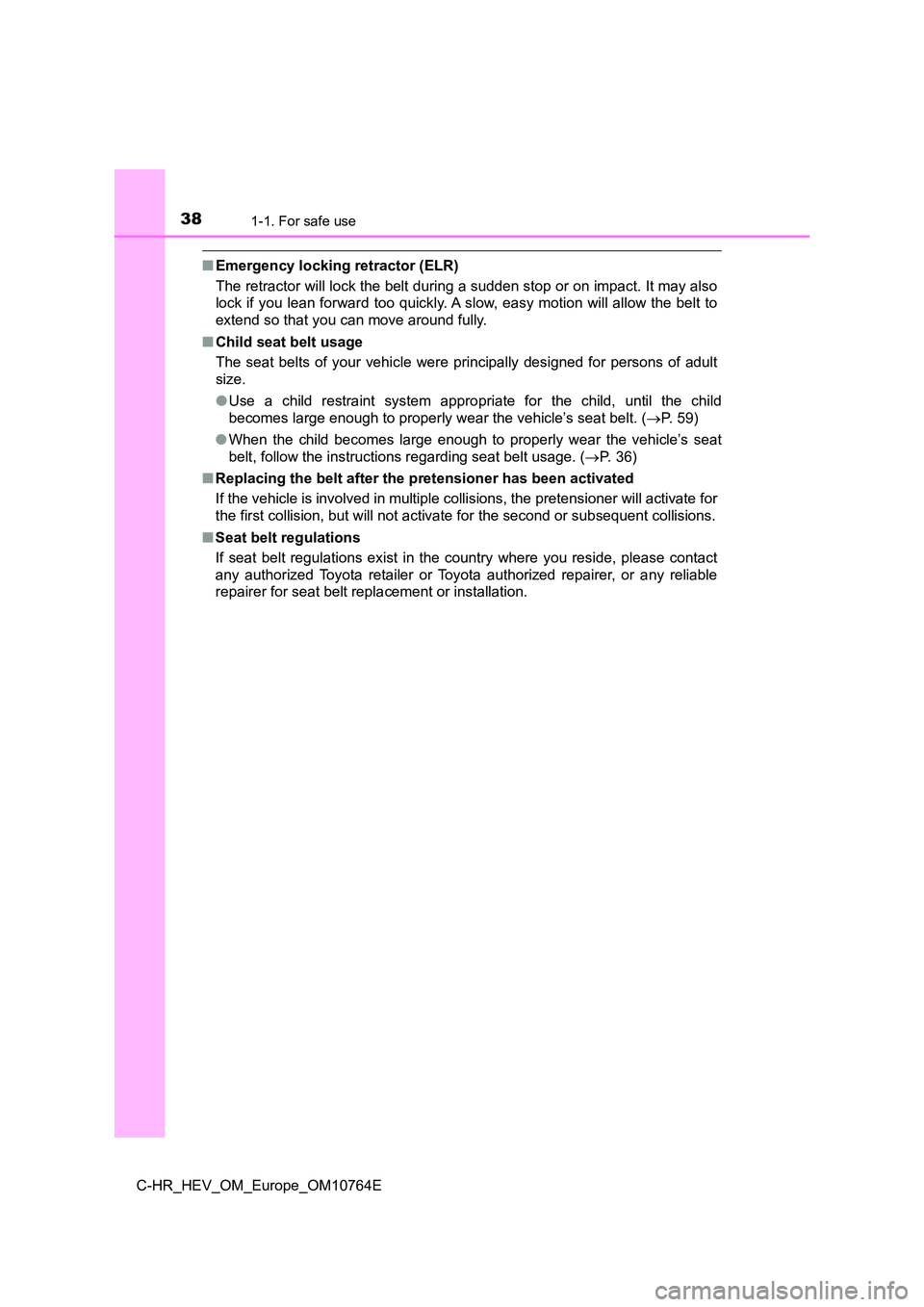
381-1. For safe use
C-HR_HEV_OM_Europe_OM10764E
■Emergency locking retractor (ELR)
The retractor will lock the belt during a sudden stop or on imp act. It may also
lock if you lean forward too quickly. A slow, easy motion will allow the belt to
extend so that you can move around fully.
■ Child seat belt usage
The seat belts of your vehicle were principally designed for pe rsons of adult
size.
● Use a child restraint system appropriate for the child, until the child
becomes large enough to properly wear the vehicle’s seat belt. (P. 5 9 )
● When the child becomes large enough to properly wear the vehicle’s seat
belt, follow the instructions regarding seat belt usage. ( P. 36)
■ Replacing the belt after the pretensioner has been activated
If the vehicle is involved in multiple collisions, the pretensi oner will activate for
the first collision, but will not activate for the second or su bsequent collisions.
■ Seat belt regulations
If seat belt regulations exist in the country where you reside, please contact
any authorized Toyota retailer or Toyota authorized repairer, o r any reliable
repairer for seat belt repl acement or installation.
Page 46 of 814
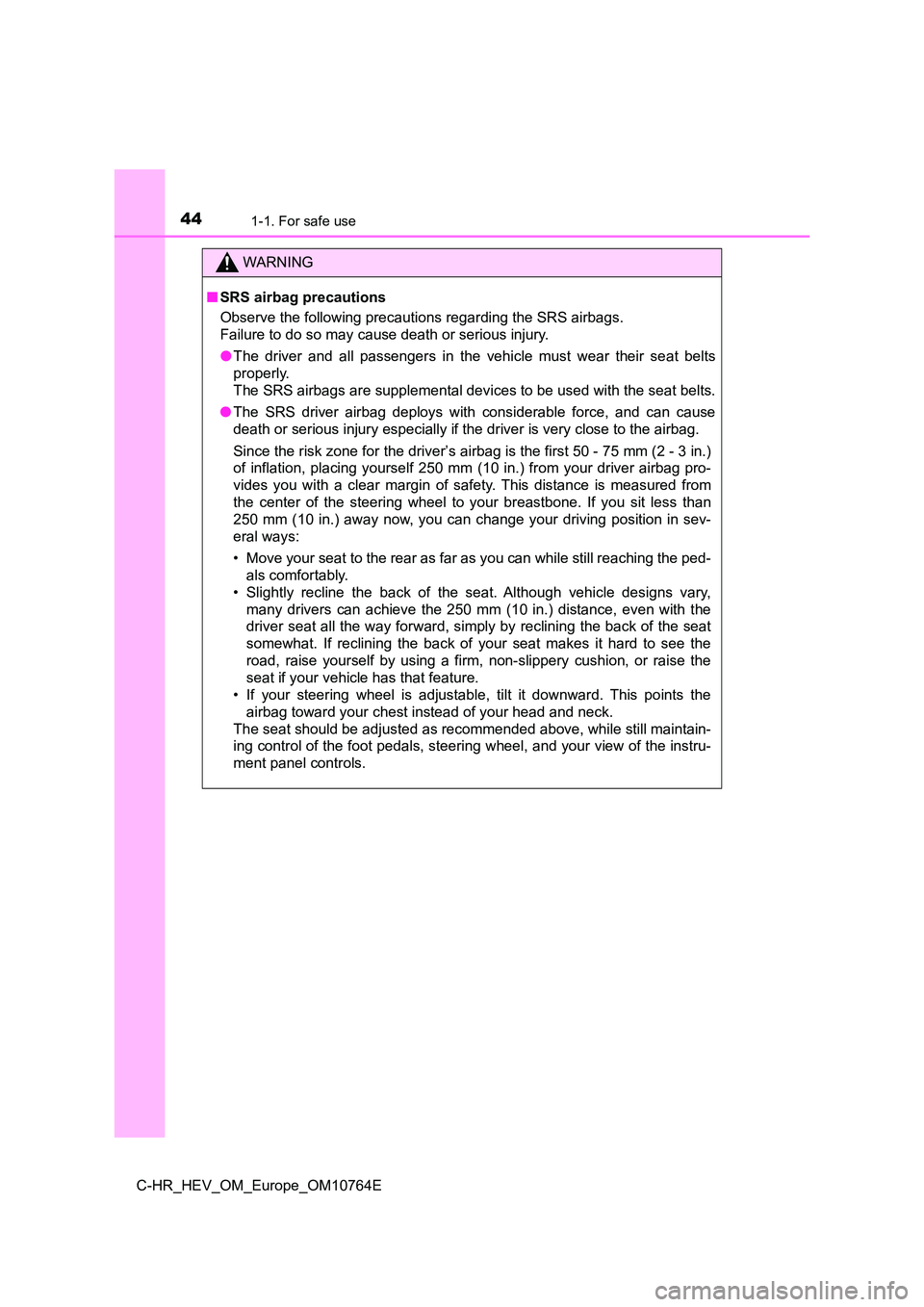
441-1. For safe use
C-HR_HEV_OM_Europe_OM10764E
WARNING
■SRS airbag precautions
Observe the following precautions regarding the SRS airbags.
Failure to do so may cause death or serious injury.
● The driver and all passengers in the vehicle must wear their seat belts
properly.
The SRS airbags are supplemental devices to be used with the se at belts.
● The SRS driver airbag deploys with considerable force, and can cause
death or serious injury especially if the driver is very close to the airbag.
Since the risk zone for the driver’s airbag is the first 50 - 7 5 mm (2 - 3 in.)
of inflation, placing yourself 250 mm (10 in.) from your driver airbag pro-
vides you with a clear margin of safety. This distance is measu red from
the center of the steering wheel to your breastbone. If you sit less than
250 mm (10 in.) away now, you can change your driving position in sev-
eral ways:
• Move your seat to the rear as far as you can while still reach ing the ped-
als comfortably.
• Slightly recline the back of the seat. Although vehicle design s vary,
many drivers can achieve the 250 mm (10 in.) distance, even wit h the
driver seat all the way forward, simply by reclining the back o f the seat
somewhat. If reclining the back of your seat makes it hard to s ee the
road, raise yourself by using a firm, non-slippery cushion, or raise the
seat if your vehicle has that feature.
• If your steering wheel is adjustable, tilt it downward. This p oints the
airbag toward your chest instead of your head and neck.
The seat should be adjusted as recommended above, while still m aintain-
ing control of the foot pedals, steering wheel, and your view o f the instru-
ment panel controls.
Page 106 of 814
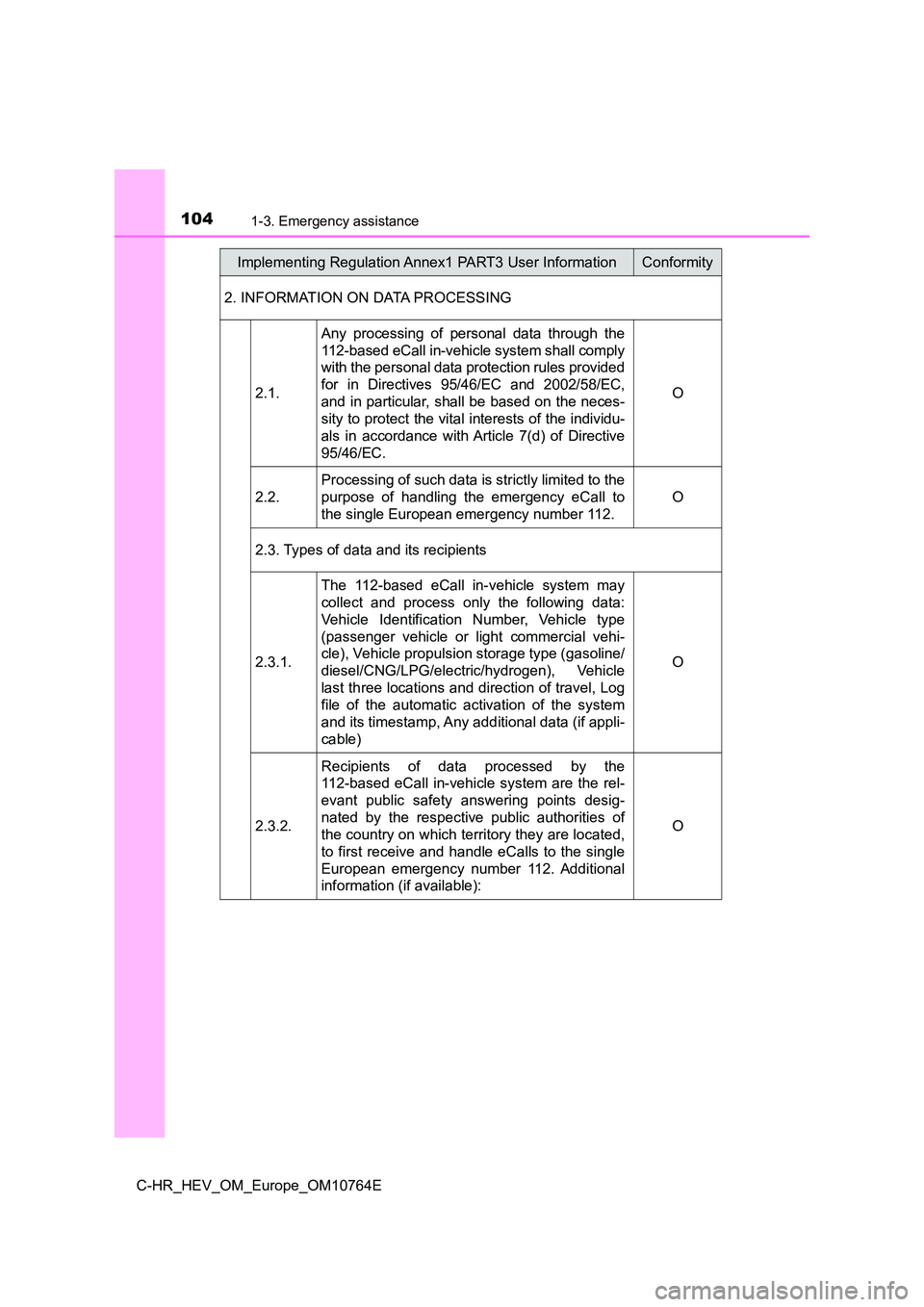
1041-3. Emergency assistance
C-HR_HEV_OM_Europe_OM10764E
2. INFORMATION ON DATA PROCESSING
2.1.
Any processing of personal data through the
112-based eCall in-vehicle system shall comply
with the personal data protection rules provided
for in Directives 95/46/EC and 2002/58/EC,
and in particular, shall be based on the neces-
sity to protect the vital interests of the individu-
als in accordance with Article 7(d) of Directive
95/46/EC.
O
2.2.
Processing of such data is strictly limited to the
purpose of handling the emergency eCall to
the single European emergency number 112.
O
2.3. Types of data and its recipients
2.3.1.
The 112-based eCall in-vehicle system may
collect and process only the following data:
Vehicle Identification Number, Vehicle type
(passenger vehicle or light commercial vehi-
cle), Vehicle propulsion storage type (gasoline/
diesel/CNG/LPG/electric/hydrogen), Vehicle
last three locations and direction of travel, Log
file of the automatic activation of the system
and its timestamp, Any additional data (if appli-
cable)
O
2.3.2.
Recipients of data processed by the
112-based eCall in-vehicle system are the rel-
evant public safety answering points desig-
nated by the respective public authorities of
the country on which territory they are located,
to first receive and handle eCalls to the single
European emergency number 112. Additional
information (if available):
O
Implementing Regulation Annex1 PART3 User InformationConformity
Page 287 of 814

2854-1. Before driving
4
Driving
C-HR_HEV_OM_Europe_OM10764E
■ Breaking in your new Toyota
To extend the life of the vehicle, observing the following prec autions is recom-
mended:
● For the first 300 km (200 miles):
Avoid sudden stops.
● For the first 800 km (500 miles):
Do not tow a trailer.
● For the first 1600 km (1000 miles):
• Do not drive at extremely high speeds.
• Avoid sudden acceleration.
• Do not drive at a constant speed for extended periods.
■ Operating your vehicle in a foreign country
Comply with the relevant vehicle registration laws and confirm the availability
of the correct fuel. ( P. 767)
■ Eco-friendly driving
P. 166
WARNING
Observe the following precautions.
Failure to do so may result in death or serious injury.
■ When starting the vehicle
Always keep your foot on the brake pedal while stopped with the “READY”
indicator is illuminated. This prevents the vehicle from creepi ng.
Page 300 of 814
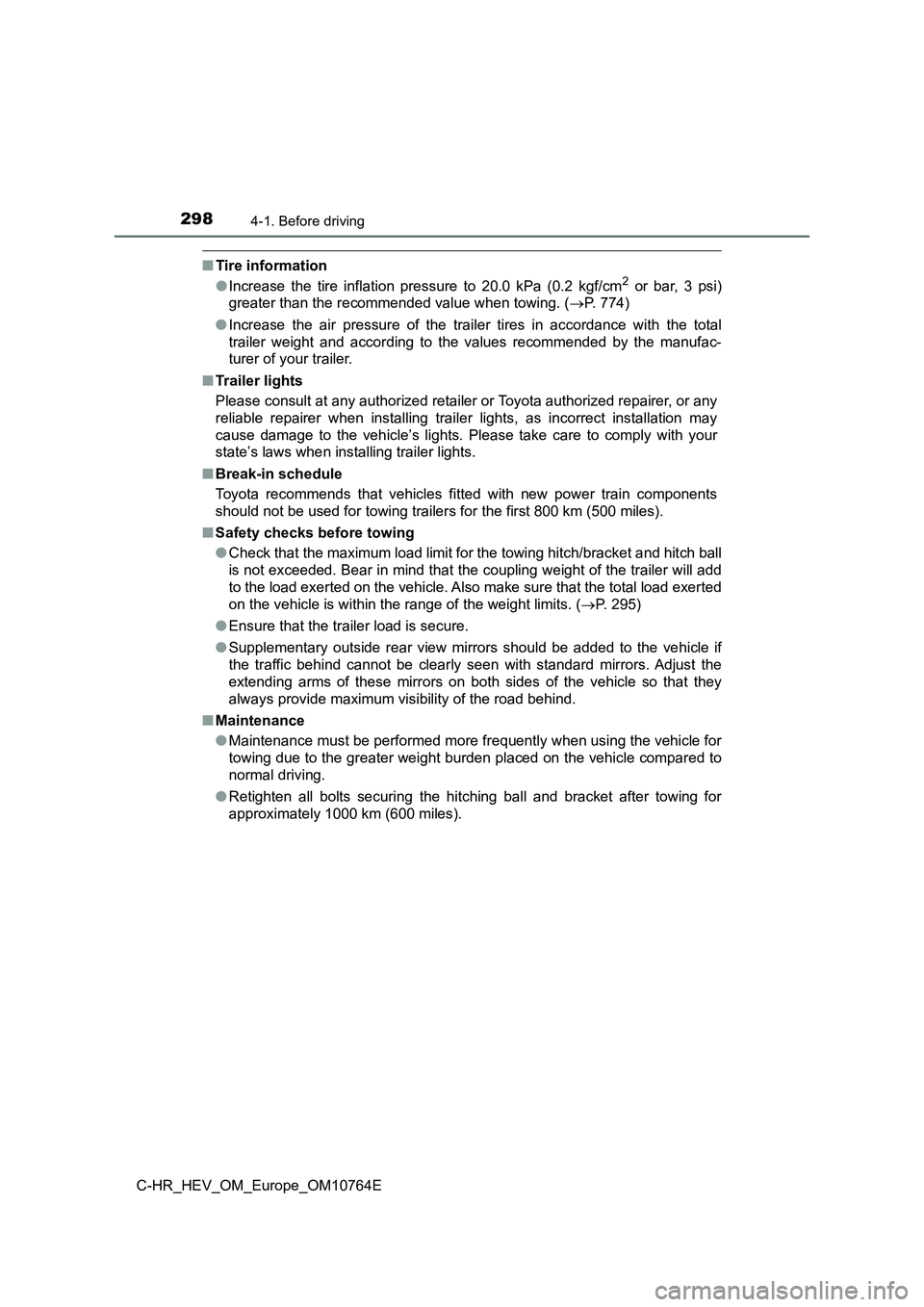
2984-1. Before driving
C-HR_HEV_OM_Europe_OM10764E
■Tire information
● Increase the tire inflation pressure to 20.0 kPa (0.2 kgf/cm2 or bar, 3 psi)
greater than the recommended value when towing. ( P. 774)
● Increase the air pressure of the trailer tires in accordance with the total
trailer weight and according to the values recommended by the m anufac-
turer of your trailer.
■ Trailer lights
Please consult at any authorized retailer or Toyota authorized repairer, or any
reliable repairer when installing trailer lights, as incorrect installation may
cause damage to the vehicle’s lights. Please take care to compl y with your
state’s laws when installing trailer lights.
■ Break-in schedule
Toyota recommends that vehicles fitted with new power train com ponents
should not be used for towing trailers for the first 800 km (50 0 miles).
■ Safety checks before towing
● Check that the maximum load limit for the towing hitch/bracket and hitch ball
is not exceeded. Bear in mind that the coupling weight of the t railer will add
to the load exerted on the vehicle. Also make sure that the tot al load exerted
on the vehicle is within the range of the weight limits. ( P. 295)
● Ensure that the trailer load is secure.
● Supplementary outside rear view mirrors should be added to the vehicle if
the traffic behind cannot be clearly seen with standard mirrors . Adjust the
extending arms of these mirrors on both sides of the vehicle so that they
always provide maximum visibility of the road behind.
■ Maintenance
● Maintenance must be performed more frequently when using the vehicle for
towing due to the greater weight burden placed on the vehicle c ompared to
normal driving.
● Retighten all bolts securing the hitching ball and bracket after towing for
approximately 1000 km (600 miles).
Page 315 of 814
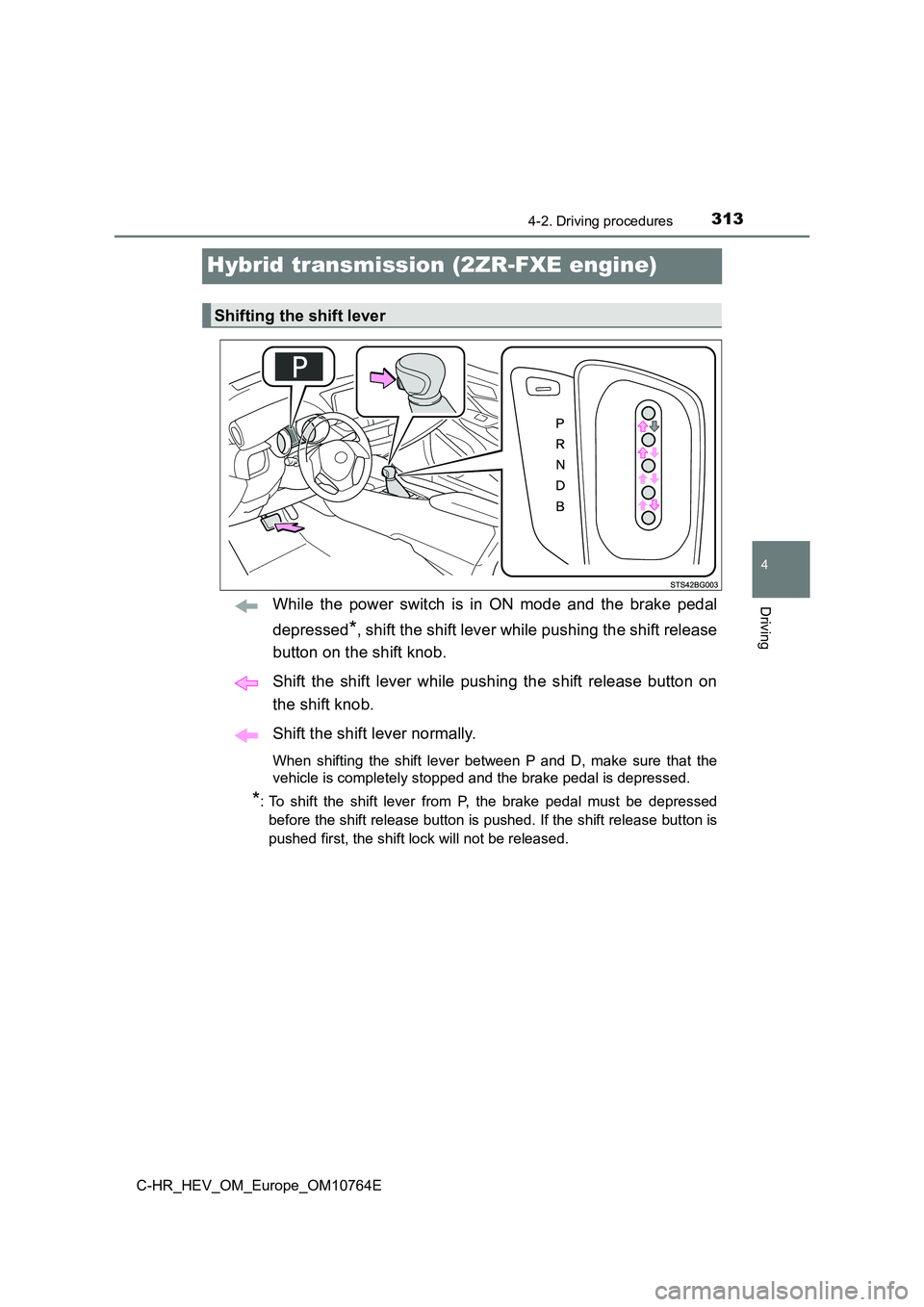
313
4
4-2. Driving procedures
Driving
C-HR_HEV_OM_Europe_OM10764E
Hybrid transmission (2ZR-FXE engine)
While the power switch is in ON mode and the brake pedal
depressed*, shift the shift lever while pushing the shift release
button on the shift knob.
Shift the shift lever while pushing the shift release button on
the shift knob.
Shift the shift lever normally.
When shifting the shift lever between P and D, make sure that t he
vehicle is completely stopped and the brake pedal is depressed.
*: To shift the shift lever from P, the brake pedal must be depre ssed
before the shift release button is pushed. If the shift release button is
pushed first, the shift lock will not be released.
Shifting the shift lever
Page 317 of 814

3154-2. Driving procedures
4
Driving
C-HR_HEV_OM_Europe_OM10764E
■ If the shift lever cannot be shifted from P
First, check whether the brake pedal is being depressed.
If the shift lever cannot be shifted with your foot on the brak e pedal while
pressing the button on the shift knob, there may be a problem w ith the shift
lock system. Have the vehicle inspected by any authorized Toyot a retailer or
Toyota authorized repairer, or any reliable repairer immediatel y.
The following steps may be used as an emergency measure to ensu re that
the shift lever can be shifted.
Releasing the shift lock:
Set the parking brake.
Turn the power switch off.
Depress the brake pedal.
■ About engine braking
When shift position B is selected, releasing the accelerator pe dal will apply
engine braking.
● When the vehicle is driven at high speeds, compared to ordinary gasoline-
fueled vehicles, the engine braki ng deceleration is felt less than that of other
vehicles.
● The vehicle can be accelerated even when shift position B is selected.
If the vehicle is driven continuously in the B position, fuel e fficiency will
become low. Usually, select the D position.
Remove the cover.
Remove the cover using flathead
screwdriver. To prevent damage to the
cover, tip the screwdriver with a rag.
Press the shift lock override button
while pressing the button on the shift
knob.
The shift lever can be shifted while the
button is pressed.
1
2
3
4
5
Page 319 of 814
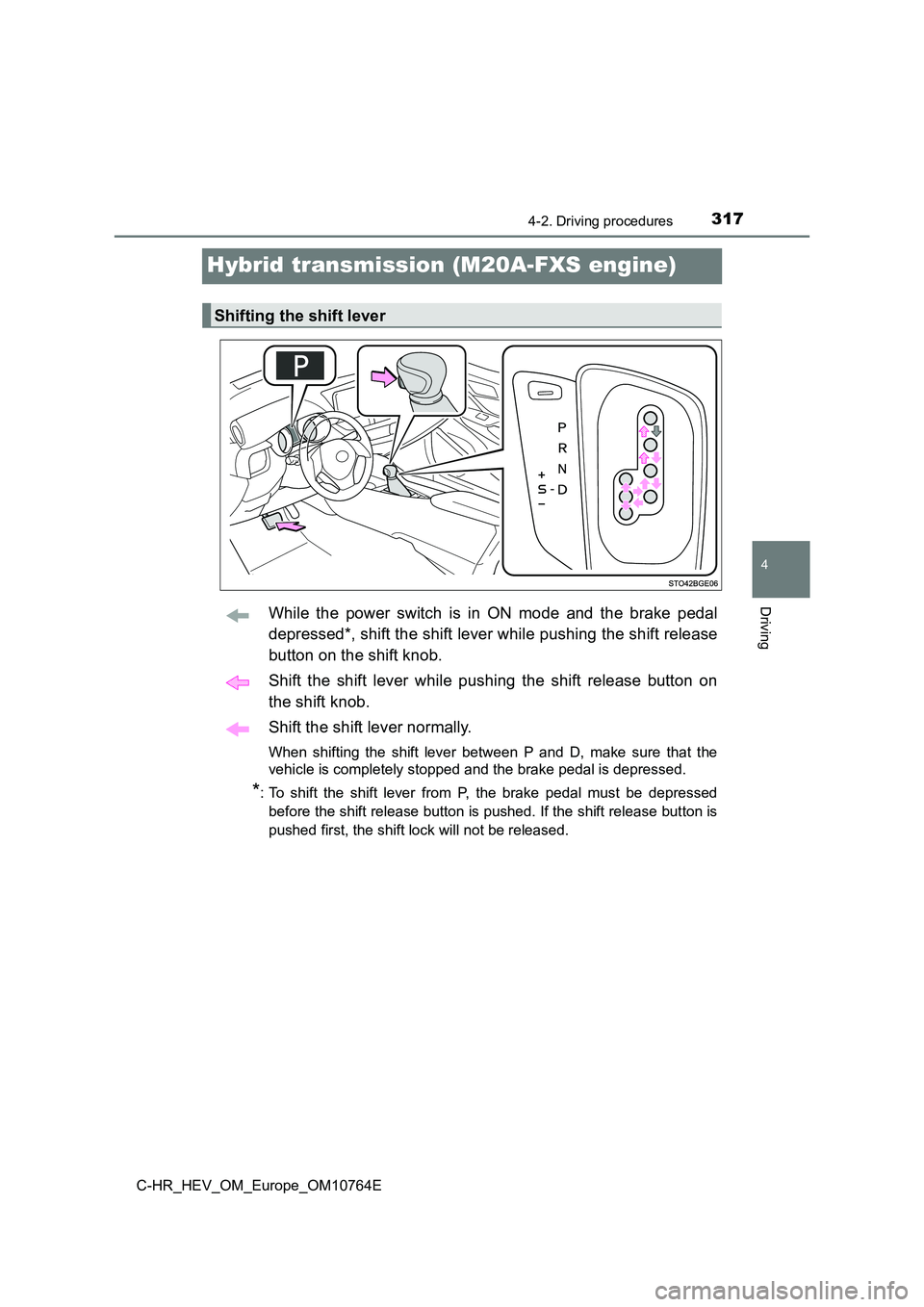
317
4
4-2. Driving procedures
Driving
C-HR_HEV_OM_Europe_OM10764E
Hybrid transmission (M20A-FXS engine)
While the power switch is in ON mode and the brake pedal
depressed*, shift the shift lever while pushing the shift relea se
button on the shift knob.
Shift the shift lever while pushing the shift release button on
the shift knob.
Shift the shift lever normally.
When shifting the shift lever between P and D, make sure that t he
vehicle is completely stopped and the brake pedal is depressed.
*: To shift the shift lever from P, the brake pedal must be depressed
before the shift release button is pushed. If the shift release button is
pushed first, the shift lock will not be released.
Shifting the shift lever